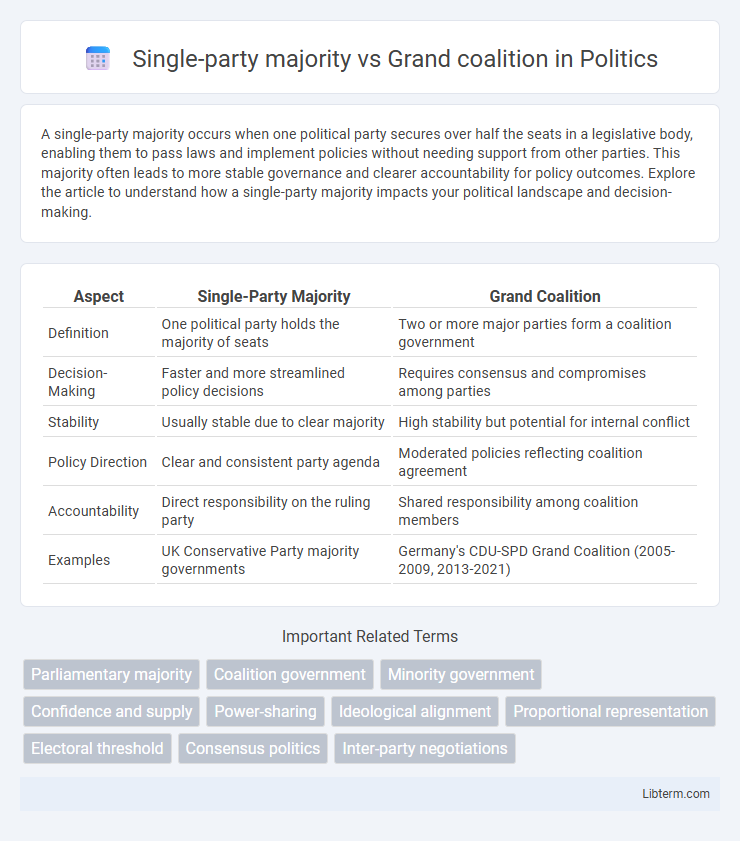A single-party majority occurs when one political party secures over half the seats in a legislative body, enabling them to pass laws and implement policies without needing support from other parties. This majority often leads to more stable governance and clearer accountability for policy outcomes. Explore the article to understand how a single-party majority impacts your political landscape and decision-making.
Table of Comparison
| Aspect | Single-Party Majority | Grand Coalition |
|---|---|---|
| Definition | One political party holds the majority of seats | Two or more major parties form a coalition government |
| Decision-Making | Faster and more streamlined policy decisions | Requires consensus and compromises among parties |
| Stability | Usually stable due to clear majority | High stability but potential for internal conflict |
| Policy Direction | Clear and consistent party agenda | Moderated policies reflecting coalition agreement |
| Accountability | Direct responsibility on the ruling party | Shared responsibility among coalition members |
| Examples | UK Conservative Party majority governments | Germany's CDU-SPD Grand Coalition (2005-2009, 2013-2021) |
Understanding Single-Party Majority Governments
Single-party majority governments occur when a single political party secures more than half of the seats in a legislative body, enabling it to govern without relying on coalition partners. This governance style provides clear accountability and streamlined decision-making, allowing for the implementation of policies reflecting the party's platform without significant compromise. Contrastingly, grand coalitions involve multiple major parties sharing power, often leading to broader consensus but potential policy gridlock.
What Is a Grand Coalition?
A grand coalition is a political alliance formed between the largest parties, typically encompassing both major left-wing and right-wing factions to achieve a broad governing majority. This arrangement contrasts with a single-party majority government, where one party holds over 50% of parliamentary seats, enabling it to govern without formal alliances. Grand coalitions often emerge in times of crisis or political deadlock, promoting stability but sometimes leading to diluted policy agendas due to the need for consensus among diverse party interests.
Historical Contexts: When Each System Emerges
Single-party majority governments often emerge in political systems with dominant parties and stable electoral majorities, common in countries like the United States and the United Kingdom during periods of political consolidation. Grand coalitions typically arise in fragmented or highly polarized parliamentary systems, such as post-war Germany or Italy, where no single party secures a clear majority and collaboration is necessary to ensure governance and political stability. Historical contexts influencing these systems include electoral laws, party fragmentation, and crises requiring broad consensus, shaping when each government form is preferred.
Advantages of Single-Party Majority Rule
Single-party majority rule enables swift policymaking and legislative efficiency by eliminating the need for extensive negotiation among multiple parties, ensuring coherent and unified government action. This governance structure fosters clear accountability, allowing voters to directly attribute successes or failures to one party, thereby enhancing democratic responsiveness. Moreover, single-party majorities reduce the risk of policy gridlock and ideological dilution commonly seen in grand coalitions, promoting stable and decisive leadership.
Benefits and Drawbacks of Grand Coalitions
Grand coalitions, formed by multiple major parties, enhance political stability and facilitate broad consensus in governance, often leading to comprehensive policy-making that reflects diverse societal interests. However, they can dilute party identities, reduce opposition effectiveness, and slow decision-making processes due to the need for compromise among coalition partners. This can result in voter dissatisfaction and challenges in holding leaders accountable, contrasting with the clearer mandates typically offered by single-party majority governments.
Policy Stability: Comparing Both Systems
Single-party majority governments typically offer greater policy stability due to streamlined decision-making and coherent agendas, reducing legislative gridlock. Grand coalitions, composed of multiple major parties, often face challenges in policy consistency as compromises can dilute initiatives and delay implementation. Empirical studies show that single-party regimes sustain long-term policy agendas more effectively, while grand coalitions prioritize consensus, which may impact the speed and clarity of policy outcomes.
Voter Representation and Satisfaction
Single-party majority governments often provide clearer policy direction and stronger voter alignment since they directly reflect the mandate of the predominant political party, leading to higher voter satisfaction among their supporters. Grand coalitions, by combining multiple major parties, ensure broader representation across diverse voter groups but may dilute policy preferences and cause dissatisfaction due to compromises. Voter representation in single-party majorities is more straightforward, yet grand coalitions enhance inclusivity at the expense of perceived decisiveness.
Challenges in Decision-Making Processes
Single-party majority governments face challenges such as limited diverse perspectives, potentially leading to policy blind spots and reduced checks on power. Grand coalitions struggle with reconciling conflicting party agendas, creating prolonged negotiations and diluted policy outcomes. Both structures must balance efficiency with inclusivity to maintain effective governance.
Impact on Political Polarization
Single-party majorities often intensify political polarization by enabling dominant parties to implement policies without compromise, marginalizing opposition voices, and deepening ideological divides. In contrast, grand coalitions foster political consensus and moderation by integrating diverse party platforms, reducing extreme partisanship, and encouraging collaborative governance. Empirical studies reveal that countries with frequent grand coalitions experience lower levels of parliamentary conflict and public political polarization.
Case Studies: Notable Examples Worldwide
Germany's Grand coalition between the CDU/CSU and SPD during 2013-2017 showcased effective governance despite ideological differences, stabilizing the economy and navigating the Eurozone crisis. In contrast, the United Kingdom's single-party majority Conservative government under Theresa May (2017-2019) struggled with Brexit negotiations, highlighting challenges in managing divisive national issues without coalition support. South Africa's ANC single-party majority has maintained consistent policy implementation since 1994, whereas Italy's frequent grand coalitions reveal political fragmentation impacts governance stability.
Single-party majority Infographic

 libterm.com
libterm.com